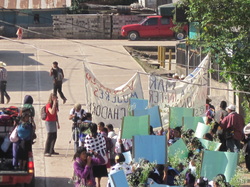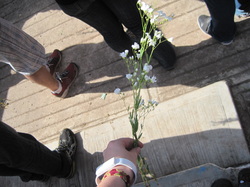About halfway through our stay here in Guate, we had to make a trip up to Mexico to renew our visas. And so we embarked on our international trip, and we did so just in time for International women's day. Our fearless leader... er.. program director had arranged for us to observe a march/protest of indigenous women. We were observing because we weren't legally allowed to participate, but observing involved walking along behind the people participating. The march was not only to honor International Women's Day, but also to commemorate a massacre of 40 people from an indigenous town in the area. A tale that is all too common, not just in Mexico, but in Guatemala as well, where several similar marches took place on that same day.

We had originally been told that the march would be only 1 hour long, and since the day had started out pretty cool and cloudy, many of us failed to bring sun screen and sufficient water. Four and half hours and 10 kilometers later, we finally finished "observing" the march. Alas, this is one of the lessons we have painfully learned here in Central America: when someone tells you that a hike is going to take about two hours, multiply that by at least two, if not three or four. Despite the fuzzy scheduling, we all fared pretty well. Considering that many of the indigenous women were marching in their full trajes, which included a heavy fur-type skirt, and frequently were walking without shoes while also carrying babies or small , we had it easy!

White flowers handed out to everyone at the march
The women passed out a list of Consignas or statements which they then shouted the entire time during the march. Below I've translated just a few of the statements:
As women...
As women...
- we have bravery to defend our town
- we want peace, justice, and dignity
- we are not slaves
- we give respect to the women of Chiapas and the world.
Aside from the obviously less than ideal physical circumstances in which these women marched, what actually impressed me more was the male presence at the march. In the U.S., if we had a march like this, I'd be surprised to see more than a handful of men coming to lend their voices to the cry for gender equality. There in Chiapas almost half of those marching were male. The male elders and other men marched along with the women, or facilitated the march by directing traffic around it and over all were very clearly there to support, but at the same time the march was clearly led by and for the women. It was very awesome and heartening to see this level of support in a society which has been known for it's machista (sexist) attitudes. All in all, I was glad that we got to observe International Women's Day in such a unique and empowering way.

 RSS Feed
RSS Feed